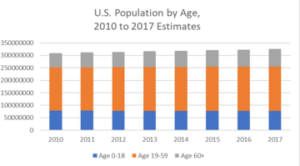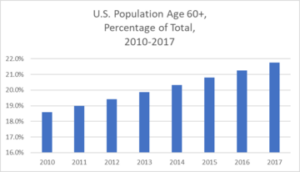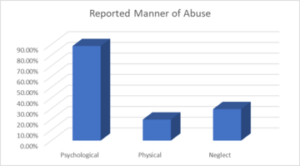Elder Abuse and Neglect is Growing With the Aging Population
Abuse at all ages is a common trope in the news these days. One population that is sometimes ignored from a media standpoint is the elderly. Those who can no longer care for themselves have limited options available. Some might rely on family – who may or may not be available – to help them meet their needs while living at home. Others are able to hire outside help to come into their homes and assist with basic care. If all else fails, many elderly individuals have no choice but to enter retirement homes, where regulators devote too few resources to a growing problem. Often, oversight falls to the senior’s family members; as discussed above, these relatives are often unavailable, unwilling, or simply unable to monitor conditions.
The issue of elderly abuse is worsening simply because the fraction of the U.S. population that is above 60 is steadily increasing. If you look carefully at the chart below, you will notice that the two segments that are increasing in size are ages 1-18 and age 60+. The only group that is steadily decreasing in terms of its share of the U.S. population is age 19-59. This is a grave concern, because that demographic is the one we would expect to be caring for the 60+ population as their needs increase.

The chart below gives a clearer picture of the increase in the percentage of the U.S. population that is elderly. This percentage has risen from roughly 18.5% in 2010 to over 21% in 2017. This is due to a variety of factors. Medical care has improved over the last 10 years. The birth rate has fallen due to a variety of factors, including better access to contraception and more women waiting until they have a career to start a family. Whatever the reason, the number of individuals who may need care due to their age is steadily climbing, while the number of people able to provide that care – as well as the resources needed to do so – is remaining static.

Because there is an aging population in the United States that is often under-served, cases of elder abuse are surprisingly common. A 2010 study found that 47% of participants with dementia had been mistreated by their caregivers in some way. Of them, 88.5% experienced psychological abuse, 19.7% experienced physical abuse, and 29.5% experienced neglect. [1]

In recognition of the seriousness of this problem, the office of Nevada’s Attorney General recently released a guide to help law enforcement officials recognize signs of elder abuse among the senior population. [2] In addition, the agency hopes to help victims access much-needed services. In order to meet this goal, he has earmarked grant money that will go towards direct services for elder victims of abuse, including sexual and domestic abuse, financial exploitation, and neglect. These expanded resources are especially important in the state’s large rural territories. Although more than three-quarters of the state’s population resides in the Las Vegas metropolitan area (in communities including Henderson, Las Vegas, and North Las Vegas), the rural areas have significant aging populations and many fewer services than the state’s urban hubs.
While this is a nationwide, demographic challenge many decades in the making, the citizens and policy officials of Nevada must confront the trend on their own. And with the trends as they are, there is no time to waste.
[1] https://ncea.acl.gov/whatwedo/research/statistics.html

